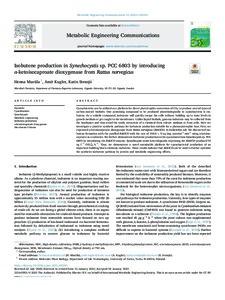Isobutene production in Synechocystis sp. PCC 6803 by introducing α-ketoisocaproate dioxygenase from Rattus norvegicus
Kugler Amit; Stensjö Karin; Mustila Henna
https://urn.fi/URN:NBN:fi-fe2021042826752
Tiivistelmä
Cyanobacteria can be utilized as a platform for direct phototrophic conversion of CO2 to produce several types of carbon-neutral biofuels. One promising compound to be produced photobiologically in cyanobacteria is isobutene. As a volatile compound, isobutene will quickly escape the cells without building up to toxic levels in growth medium or get caught in the membranes. Unlike liquid biofuels, gaseous isobutene may be collected from the headspace and thus avoid the costly extraction of a chemical from culture medium or from cells. Here we investigate a putative synthetic pathway for isobutene production suitable for a photoautotrophic host. First, we expressed α-ketoisocaproate dioxygenase from Rattus norvegicus (RnKICD) in Escherichia coli. We discovered isobutene formation with the purified RnKICD with the rate of 104.6 ± 9 ng (mg protein)-1 min-1 using α-ketoisocaproate as a substrate. We further demonstrate isobutene production in the cyanobacterium Synechocystis sp. PCC 6803 by introducing the RnKICD enzyme. Synechocystis strain heterologously expressing the RnKICD produced 91 ng l−1 OD750−1 h−1. Thus, we demonstrate a novel sustainable platform for cyanobacterial production of an important building block chemical, isobutene. These results indicate that RnKICD can be used to further optimize the synthetic isobutene pathway by protein and metabolic engineering efforts.
Kokoelmat
- Rinnakkaistallenteet [19207]
